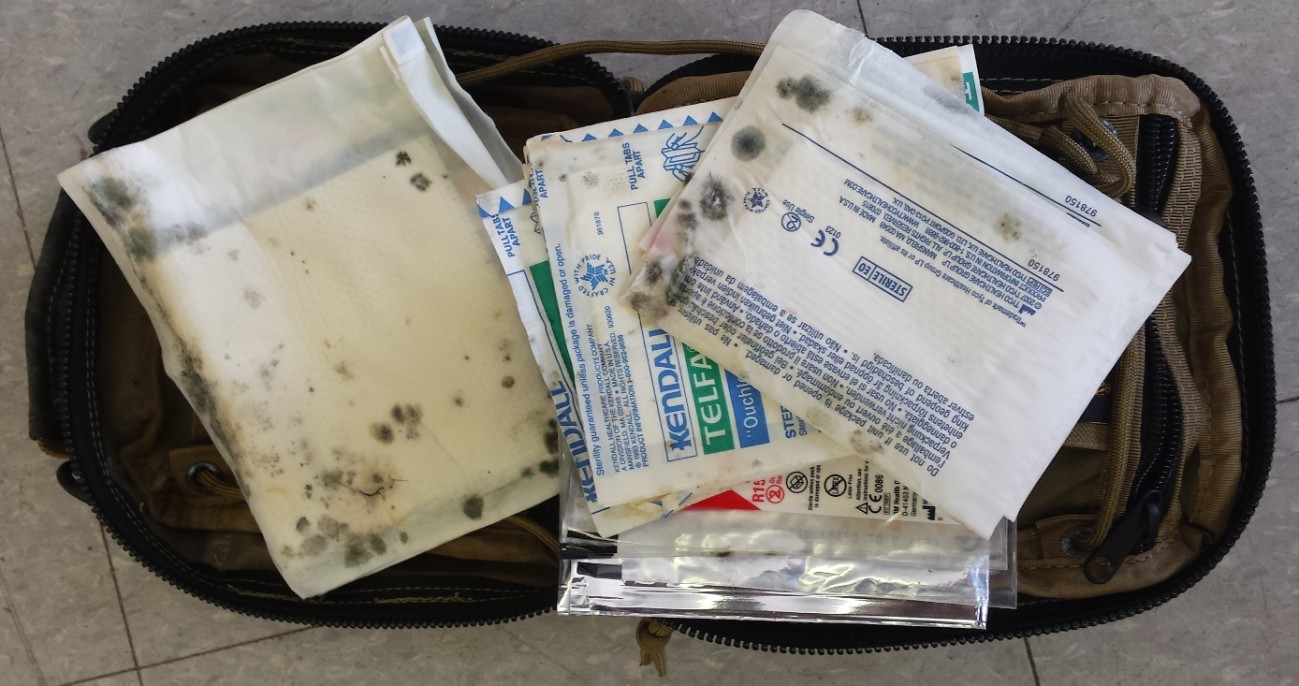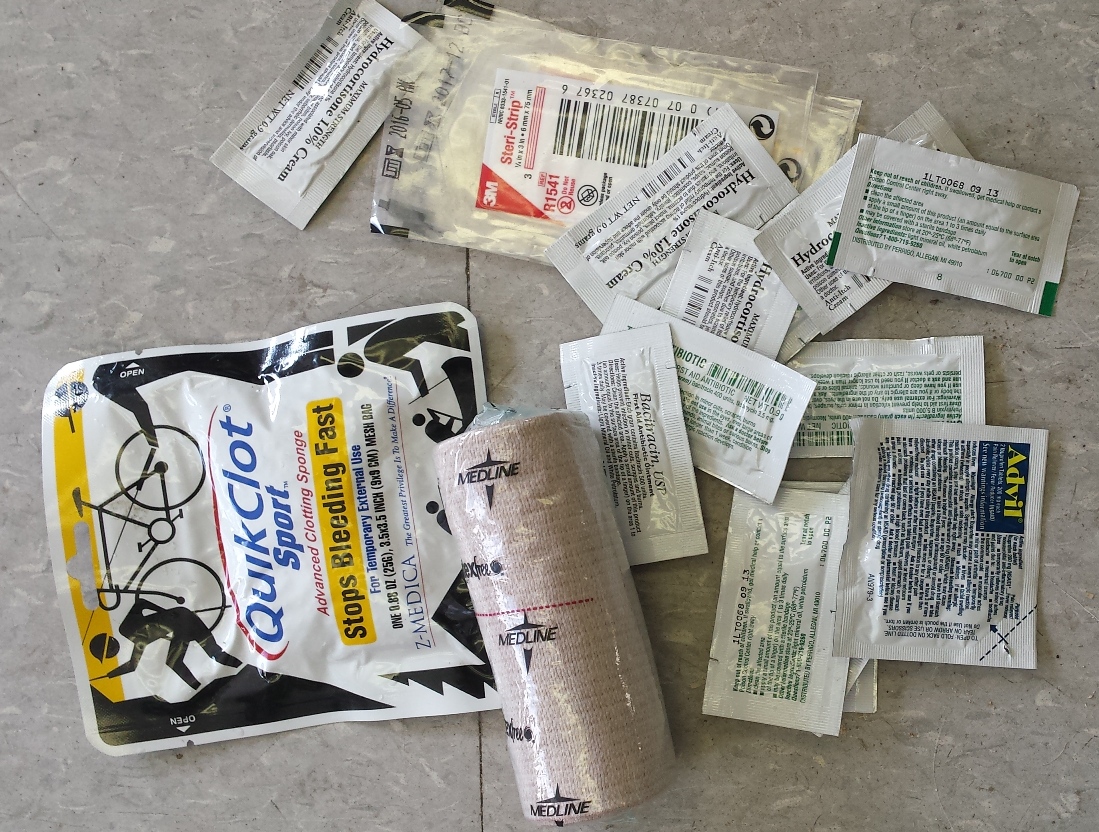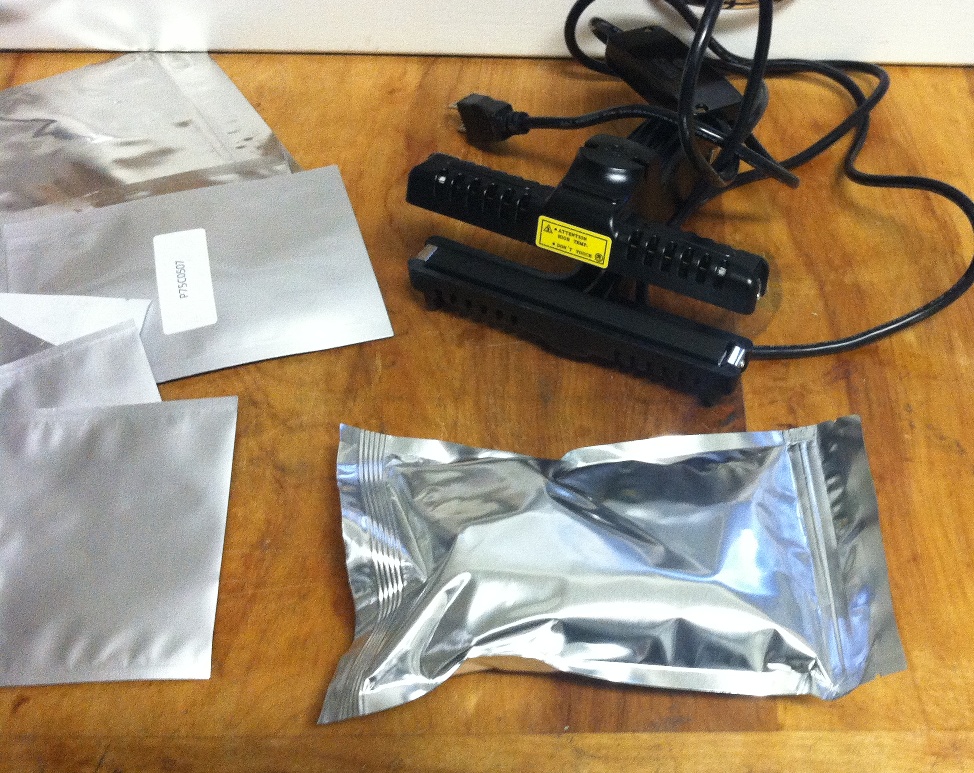Years back,I used to have a bicycle that would, at irregular intervals, try and kill me by locking up the chain for no particular reason. I eventually got a newer, better, bicycle but the old Death Machine taught me to keep a first aid kit handy. On my bike I have one of these mounted. I find it very useful, and keep my first aid kit in there. The first aid kit is one of these (Maxpedition FR-1 Pouch
) loaded with what I feel is necessary gear. Now, if you’re keeping track, that is a first aid kit contained in a cordura pouch, which is itself contained within a cordura bicycle bag. What could go wrong?
Well, here’s the lesson for today… I left my bike chained up in the yard over the winter. As a result, the rain and snowmelt made its way through the bicycle bag and through the first aid pouch. Check this out:
 Thats not dirt, kids….thats mold. Most first aid stuff is packaged in sterilized paper envelopes and those are less waterproof. So, virtually everything was moist/damp/moldy and had to be discarded. However, some things were not damaged. Observe:
Thats not dirt, kids….thats mold. Most first aid stuff is packaged in sterilized paper envelopes and those are less waterproof. So, virtually everything was moist/damp/moldy and had to be discarded. However, some things were not damaged. Observe:
 Basically, anything packed in foil or sealed in plastic weathered it just fine.
Basically, anything packed in foil or sealed in plastic weathered it just fine.
So, by now, you’re thinking “No problemo, just seal up all the individual contents and you’ll be good to go.” A reasonable way of thinking, but it overlooks a big issue – when you need a first aid kit, theres a pretty good chance you’re under stress, your hands might be a little shaky, and you may only have one hand to work with since your other arm/hand might be injured. So, sealing things up in a manner that required two hands to open (or requires several repeated pouch-opening-procedures) might not be conducive to effective use of your gear.
Now, I rather like the Maxpedition FR pouch. It’s reasonably compact, fairly easy to organize, and has several methods for attachment to other gear. I’d hate to give it up. So, to me, the choices are two: a) individually seal the contents of the kit or b) put the whole kit into a waterproof container of some sort.
I’m leaning towards ‘A’. Best method? Well, there’s this:
 Those are heavy-duty mylar bags with ‘tear away’ tops and zip-seals, and a 6″ heat sealer that I picked up off Amazon. The bags, in various sizes and thicknesses, are from Sorbent Systems. I got them expressly for the purpose of making small, weatherproof, resealable, firs-aid kits for my hunting and outdoors gear. For example:
Those are heavy-duty mylar bags with ‘tear away’ tops and zip-seals, and a 6″ heat sealer that I picked up off Amazon. The bags, in various sizes and thicknesses, are from Sorbent Systems. I got them expressly for the purpose of making small, weatherproof, resealable, firs-aid kits for my hunting and outdoors gear. For example:
 That pouch contains most of the important stuff…gauze, non-stick pads, compress bandage, antibiotic ointment, bandaids, aspirin, tape, etc, etc. Not enough to do surgery or fix a detached aorta, but for the cuts, burns, scrapes and bloody messes that sometimes happen from bicycle accidents, knife slips, falls in blowdown snag, etc, its pretty good. And, it is now completely waterproof. Tear open at the upper corner there with your teeth and open it like a bag of chips. When done, you can reseal it with the ziploc-type closure. When the crisis is over, since I have a stack of these bags, I can simply transfer the contents to a new bag to seal. I’ll wind up getting a larger back, drop the Maxpedition FR into it, throw in a few oxygen absorbers to snug it up tight, and tuck it into my bike bag.
That pouch contains most of the important stuff…gauze, non-stick pads, compress bandage, antibiotic ointment, bandaids, aspirin, tape, etc, etc. Not enough to do surgery or fix a detached aorta, but for the cuts, burns, scrapes and bloody messes that sometimes happen from bicycle accidents, knife slips, falls in blowdown snag, etc, its pretty good. And, it is now completely waterproof. Tear open at the upper corner there with your teeth and open it like a bag of chips. When done, you can reseal it with the ziploc-type closure. When the crisis is over, since I have a stack of these bags, I can simply transfer the contents to a new bag to seal. I’ll wind up getting a larger back, drop the Maxpedition FR into it, throw in a few oxygen absorbers to snug it up tight, and tuck it into my bike bag.
Now, if you have a vacuum sealer, you can very much accomplish a similar setup using your sealer and bags. Two big differences though: the mylar pouches pictured have a ‘tear notch’ to allow easy access (which a vacuum sealed bag does not); and the mylar pouch, in this heavy thickness, is much more puncture resistant than a vacuum seal bag (however, you can always wrap the vacuum seal bag in something to protect its integrity).
I have learned my lesson and won’t be leaving this gear outside over the winter again, but walking around in a solid rain for a few hours would have probably induced the same amount of moisture into things. Waterproofing/weatherproofing an important bit of gear like this makes sense. Fortunately, today I noticed it because I was thinking I should probably check to see how the gear fared over the winter…it would have been a different story if I was a couple miles down the road, sitting on a rock, trying to bandage a gash in my leg with wet and moldy 4″ gauze and pads.

Good info Commander, Thanks.
I need to break down and pick up one of those hand held sealers.
Super convenient I bet?
It is. Whats more convenient is having a stack of those mylar bags. It puts one in the mind to make all sortsa kits and ‘just in case’ packages.
Have you thought about getting a lockable storage shed for your place?
I’d think that would be better for the gear (bike, gas cans etc) than just securing them to a large fixed object.
We’ve a good sized secure fenced yard so I dont worry about it too much.
I have 2 mountain hardware fanny packs. With a sling/shoulder strap. Smaller Is for summer. Larger for winter. I keep a ouch kit in a I quart freezer bag. Nice and light and resealable. One of these is In Each bag. I’ve been tayloring these bags to be at home running to orange street market, or a 25 mile ride in the garnets. The carry weapons include (not finished yet) a block 30 converted to 10mm. And a can of bear mace.
What kind of bags do you recommend? That page has a lot of different bags on it…
I usually go with the thickest one possible to avoid punctures.
Great article, thanks for the links to the Mylar bags and the inexpensive sealer.
I vac pac almost everything in my field medical kits – for the reason you have discovered, and to conserve space.
What I do though, is put everything in a ziplock, which I do not close, and then vac pack it. That way when I open the single-use bag, I have some way of protecting the items until I can get them replaced and resealed.
1) Any FA kit that isn’t waterproof is worthless. If not now, then when you need it, which is worse. As you’ve discovered, and as I did the first time I was working on a movie set on a rainy day. It’s a mistake you only make once.
2. Mylar is nice, but you can’t see what’s inside. Consider heavy-duty Saran wrap or equiv. as something still see-through, but easier to tear open than mylar or two-hand zip-loks.
3. If you’re any kind of handy with a sewing machine, turning mil-spec poncho materials into pack and bag condoms is a quick and elegant way to make your favorite bag far more water resistant. It also gives you options as far as external appearance, whether more camo’ed, or more non-descript than Tactical Timmy camo patterns in urban use around the unprepared muggles. YMMV.
4. Given your penchants anyways, you can get single-use heat seal clear plastic bagging material too, and simply resolve that if you tear something open for use, you’ll re-stock and re-seal it at the first opportunity.
5. As far as opening, putting a guard-protected single-edge razor or retractable box cutter in the top of the kit is never a bad idea. For some of the sterile wrap crap used in the ED, I need bandage scissors, trauma shears, and/or a hemostat (think ER pliers) just to open the goddam packaging, and that’s indoors in air-conditioned comfort, with two hands.
6. As a general rule, whether for first aid or any other kind of kit, anything that couldn’t be reliably used during a year’s service in the WWI trenches of the Somme probably isn’t proper kit to rely on, and you’ll find that out at the worst possible moment. Field-test your gear and eliminate the flaws now, when mistakes are free.
7. Just random curiosity, but for a bike kit, why not something along the lines of a screw-top or screw-twist together PVC pipe or somesuch thing, clamped/strapped/zip-tied/etc. to the frame? Bombproof, compact, and totally watertight, and you could size the tube diameter to the largest items, and adjust the length so everything fits. Just thinking out loud there.